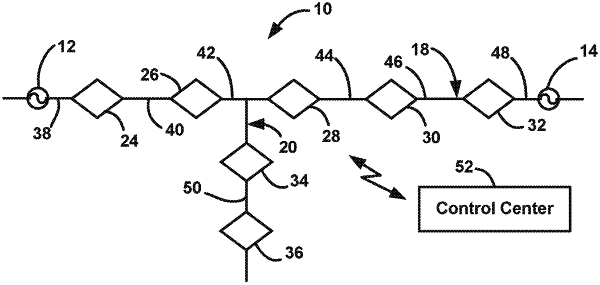| CPC G01R 31/086 (2013.01) [H02H 3/063 (2013.01); H02H 7/261 (2013.01)] | 23 Claims |

|
1. A method for locating and isolating a fault in a power distribution network, the network including at least one power source, at least one feeder and a plurality of switching devices positioned along the at least one feeder and being in communications with each other, where network sections are defined between adjacent switching devices and where all of the switching devices have overcurrent sensing capability and at least one of the switching devices does not have a voltage sensing capability, the method comprising:
detecting an overcurrent event in the network from the fault by at least some of the switching devices;
interrupting the overcurrent event by opening and then immediately locking out or performing subsequent reclosing operations by a switching device of the at least some of the switching devices that detected the overcurrent event;
increasing a count value in the switching device of the at least some of the switching devices that detected and interrupted the overcurrent event, in each of the switching devices that detected the overcurrent event and then detected loss of voltage upstream, in each of the switching devices that detected the overcurrent event and does not have a voltage sensing capability, and in each of the switching devices that detected the overcurrent event but does not have a voltage sensing capability and inferred a loss of voltage upstream by measured current;
sending a count and current (C&I) message from the each of the switching devices that detected the overcurrent event and then detected the loss of upstream voltage, from the each of the switching devices that detected the overcurrent event and has an upstream neighbor switching device that does not have a voltage sensing capability, from the each of the switching devices that detected the overcurrent event and does not have a voltage detecting capability, and from the each of the switching devices that detected the overcurrent event but does not have a voltage detecting capability and inferred loss of voltage upstream by measured current, the C&I message including a current locally measured by the sending switching devices and a count value of the sending switching devices;
starting a C&I timer in the each of the switching devices that sent a C&I message;
performing a current matching test, in each of the switching devices in which the C&I timer has expired, between the measured current received in a C&I message by that switching device and a current measured by that switching device;
populating a fault isolation table in the each switching device that detects the overcurrent event that includes its count value, its measured current and accumulated current from a received C&I message;
repeating interrupting the overcurrent event, increasing the count value, sending the C&I messages, starting the C&I timer, performing the current matching test and populating the fault isolation table;
determining that the fault is in an immediate downstream section of one of the switching devices based on the count value in the one of the switching devices matching a predetermined first count value and a current matching test failure; and
sending a downstream switch open message to an immediate downstream switching device from the one of the switching devices that determined that the fault is in the immediate downstream section to isolate a downstream end of the immediate downstream section.
|